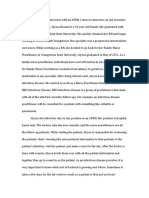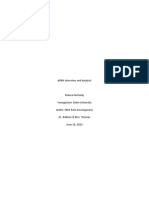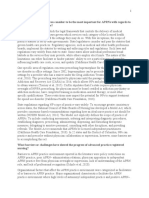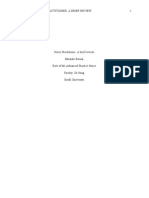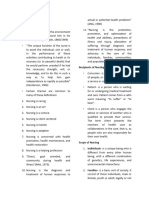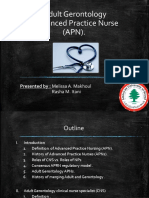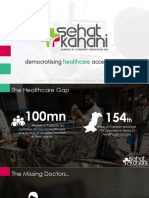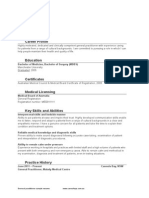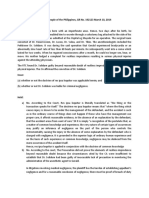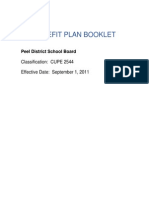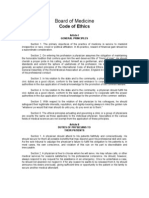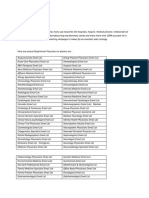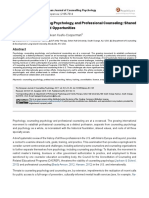Grace Gindlesperger 1
6/17/2022
Analysis and Interpretation of APRN Interview
For this interview process I had the pleasure to speak with Caleb Thibeault, an Adult
Geriatric Primary Care Nurse Practitioner (AGNP) in Fairview, Ohio. Before entering healthcare,
Caleb originally attended his undergraduate for Marine Biology, worked on a fishing farm, and
joined the Coast Guard. His military service allowed him to return to school as a second career
nurse using his GI bill. In 2015 he began his nursing career, after graduation, in the Surgical ICU
(SICU) as a bedside nurse and eventually the SICU nurse supervisor. In 2018 he graduated with
his Master of Science in Nursing through Case Western University and began practicing as an
AGNP. Since then, he has worked in the Palliative Medicine department at the Cleveland Clinic
Fairview Hospital. Caleb describes this specialty as one that assists patients with serious life
limiting illnesses to manage symptoms and discuss goals of care for end-of-life situations. While
separate from Hospice, Palliative Medicine works very closely with them to help guide end of
life care. This department is new to Cleveland Clinic’s Fairview location and was started in 2018
with the help of Dr. Katherine Eilenfeld, as well as Caleb and his team of additional Nurse
Practitioners (NPs) and Licenses Social Workers (LSWs). This is where I have had the
opportunity to meet and work with Caleb regularly in the Coronary ICU (CCU), where I am a
bedside nurse. Because of his busy work schedule, this interview process took place digitally
over Zoom, and Caleb can be seen sitting outside the hospital entrance during a work break. With
his generous participation, he was able to provide insight into the impact of Advance Practice
Registered Nurses (APRN) on healthcare, barriers they face, what changes he would like to see,
and some advice for the next generation of APRNs.
My first question for Caleb was if he felt that APRNs influence the healthcare system and
why he feels that they do or do not. He stated that APRNs do influence healthcare, but their
�Grace Gindlesperger 2
6/17/2022
impact is dependent on their scope of practice and degree of autonomy allowed. Caleb identified
that some systems, like the Veterans Affairs (VA), provide more autonomy to the NPs which
helps distribute more care to patients. This is best seen in primary care settings where most of the
roles can be taken over by an NP and allow for more patients to be seen and treated. However,
benefits are also seen in ICUs, especially overnight, where NPs can help lighten workload from
residents who, as Caleb stated, are overworked, and often sleeping. This promotes faster care,
reduced delays in medication ordering, and less strain on the physicians working in these high
demand units. A 2022 study found that the addition of NPs into an ICU resulted in shorter stays
and reduced mortality rates, likely as a result of reducing workload for physicians (Mori et al.,
2022). Caleb does comment that NPs are not there to replace Doctors and it’s important to
understand the limitations and differences with each role. However, NPs can provide the most
influence and impact on primary care areas and rural areas with limited access to physicians.
Studies have found that less restrictive NP scope of practice regulations can increase access to
primary care by around 30% (Ortiz et al., 2018). This provides a huge impact on healthcare
access to patients most at risk with statistically no difference in patient outcomes compared to
physicians providing the same care (Ortiz et al., 2018). Caleb states that he identifies the most
influence and impact in those patient populations and areas of need when more autonomy is
provided to NPs. While Ohio is not the most restrictive state, it does require all NPs practice
under a Standard Care Agreement with a physician (Ohio Administrative Code, 2022). This can
allow for a great deal of autonomy all the way to very little dependent on the facility, physician,
and area of practice. Caleb states that a lot of the influence NPs can provide is limited within
Ohio as a result of reduced autonomy and a culture of more physician centered care. He hopes to
�Grace Gindlesperger 3
6/17/2022
see the full potential of NPs and their impact on the Ohio healthcare system through better
resource utilization and more uniform regulation focused on autonomy.
My next two questions follow a lot of the ideas and concerns that Caleb already has
brought up during this interview. I asked about what barriers he feels APRNs face as well as
what changes he would like to see made for APRNs. Continuing his thoughts regarding
autonomy and optimized patient care, Caleb mentions that in his specialty of Palliative medicine
he is given significantly more autonomy than other departments in the same hospital. He talks
about how the workflow and autonomy offered to his department shows better utilization of NP
capabilities and his supervising physician, Dr. Eilenfeld, acts as a resource more than a
supervisor. He describes the lack of autonomy in other departments as a barrier to those NPs and
promotes traditional physician focused care. Their skills are not being used in a way to optimize
care, instead they are often slowed down by having to discuss all decisions with the supervising
physician thus delaying treatment and care. This type of resource management is often a result of
culture within a department or hospital. The misunderstanding and diminishing of the APRNs
abilities create barriers to their daily practice and care they can provide. Relaxing NP scope of
practice laws has been found to increase the value of care that primary practices can provide by
employing NPs who can both practice and bill independently (Smith, 2021). When asked about
changes he would like to see made for APRNs, he hopes to see more full autonomy and
standardized scope of practice policies being implemented. Caleb brings up a concern within his
own department as an example. While he states he has a lot of autonomy and independence in
the Palliative Medicine field, he is unable to pronounce hospice patients who have passed
without a physician. Even though he is legally allowed in the state of Ohio to do so, it is
restricted within this specific branch of the Cleveland Clinic. This creates situations where he is
�Grace Gindlesperger 4
6/17/2022
unable to pronounce patients that have been in his direct care for many months and with whom
he has formed relationships and trust with. Instead of a closed-loop management of the end of
life for someone who he is very familiar with, he must involve residents who are not involved
with the patient at all. Even more frustrating to him is that hospice nurses are given authority to
pronounce at other Cleveland Clinic locations, but NPs are not. Caleb hopes to see full autonomy
and standard universal policy being implemented to utilize NPs to their fullest potential to
promote better patient care.
As a final question, I asked what advice Caleb had for the next generation of APRNs as
they enter the workforce. He responded simply with “Be humble.”. He stated that a lot of the
knowledge and skills used as a nurse, while useful and important, need to be adjusted for the new
position. Coming into the field knowing that you do not know it all and a lot is still left to learn is
paramount. Throughout this interview, a major theme was the presence or lack of full autonomy
and the impact it has on APRNs, patients, and healthcare as a whole. This interview has given me
insight into the impact that APRNs have and how there is still a lot of potential that isn’t being
utilized. Recognizing the barriers in place for future APRNs will help us promote change and
forward progression of APRN autonomy and continue to provide positive impacts on the
healthcare system.
�Grace Gindlesperger 5
6/17/2022
References
Mori, K., Tsukamoto, Y., Makino, S., Takabayashi, T., Kurosawa, M., Ohashi, W., Okumura,
M., Fujita, Y., & Fujiwara, Y. (2022). Effect of intensive care provided by nurse
practitioners for postoperative patients: A retrospective observational before-and-after
study. PLOS ONE, 17(1). https://doi.org/10.1371/journal.pone.0262605
Ohio Administrative Code. (2022, February 1). Rule 4723-8-04: Standard Care Arrangement for
a certified nurse-midwife, certified nurse practitioner, and Clinical Nurse Specialist. Rule
4723-8-04 - Ohio Administrative Code | Ohio Laws. https://codes.ohio.gov/ohio-
administrative-code/rule-4723-8-04
Ortiz, J., Hofler, R., Bushy, A., Lin, Y., Khanijahani, A., & Bitney, A. (2018). Impact of nurse
practitioner practice regulations on rural population health outcomes. Healthcare, 6(2), 65–
66. https://doi.org/10.3390/healthcare6020065
Smith, L. B. (2021). The effect of nurse practitioner scope of practice laws on Primary Care
Delivery. Health Economics, 31(1), 21–41. https://doi.org/10.1002/hec.4438
YouTube. (2023). Interview with an APRN. YouTube. Retrieved June 17, 2023, from
https://www.youtube.com/watch?v=M9-cqeIXw40.



